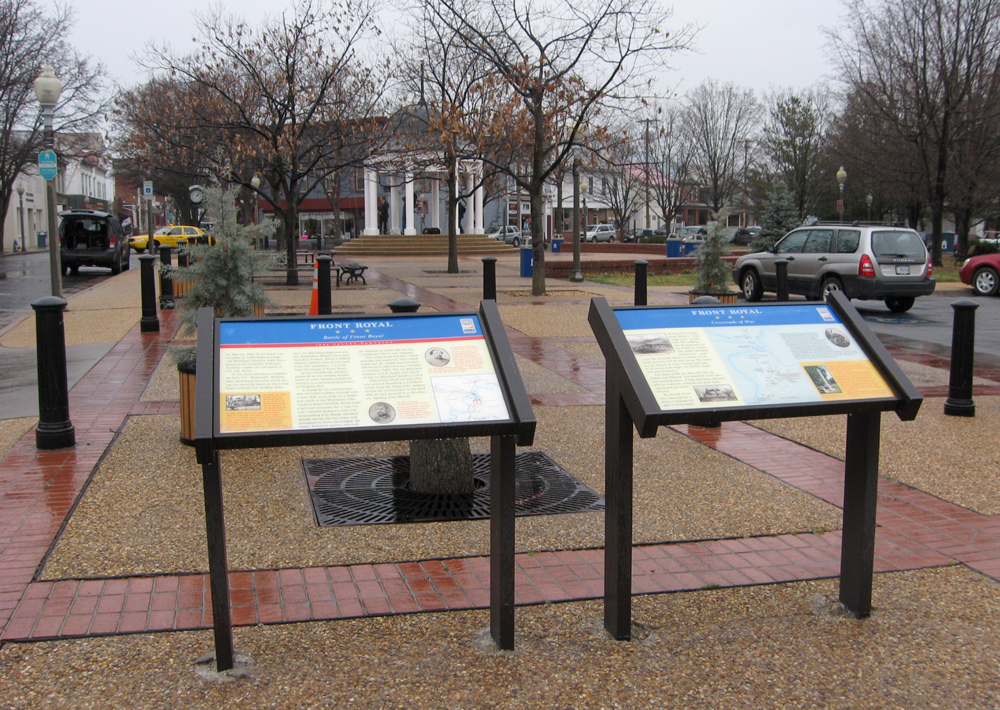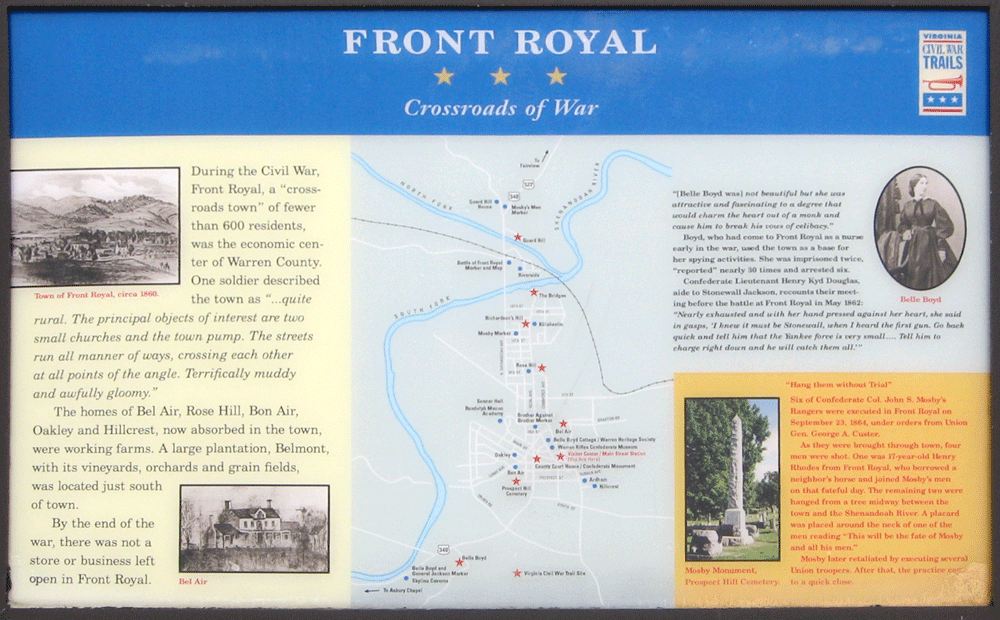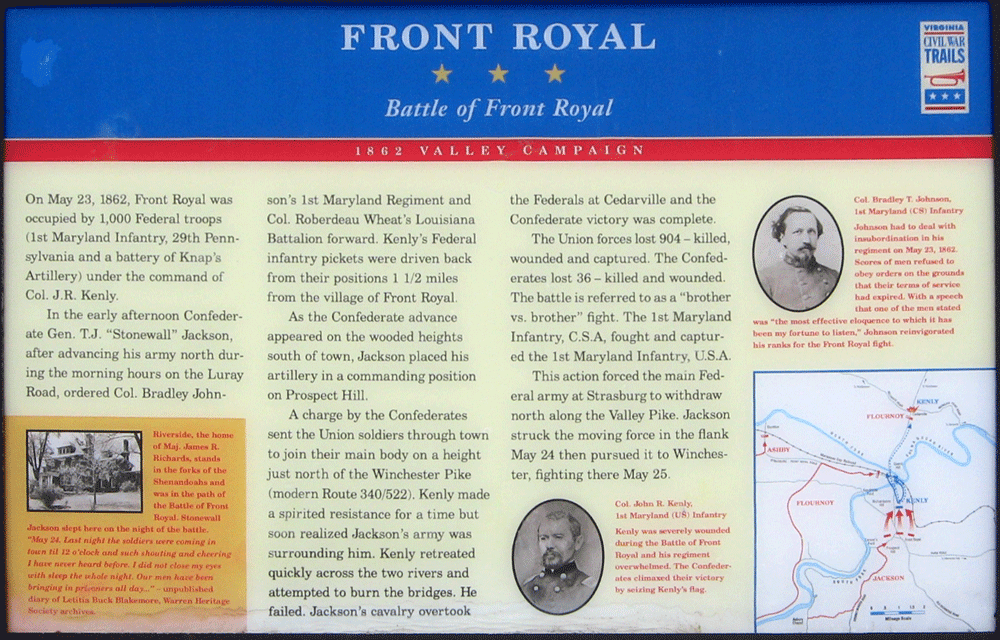Front Royal – Monuments and Markers – 1862 Valley Campaign
The two wayside markers, “Battle of Front Royal” and “Crossroads of War”, are in the plaza beside the Front Royal Visitor Center next to the public paring lot. (38°55’03.1″N 78°11’22.1″W; see map below)
The markers are the fifth stop in the Civil War Trails tour of the Battle of Front Royal.
(< Previous stop, The Courthouse • Next stop, Bel Air >)

From the Crossroads of War marker:
Front Royal
Crossroads of War
During the Civil War, Front Royal, a “cross-roads town” of fewer than 600 residents, was the economic center of Warren County. One soldier described the town as “…quite rural. The principal objects of interest are two small churches and the town pump. The streets run all manner of ways, crossing each other at all points of the angle. Terrifically muddy and awfully gloomy.”
The homes of Bel Air, Rose Hill, Bon Air, Oakley and Hillcrest, now absorbed in the town, were working farms. A large plantation, Belmont, with its vinyards, orchards and grain fields, was located just south of town.
By the end of the war, there was not a store or business open in Front Royal.
From the sidebar in the upper right of marker:
“(Belle Boyd was) not beautiful but she was attractive and fascinating to a degree that would charm the heart out of a monk and cause him to break his vows of celibacy.”
Boyd, who had come to Front Royal early in the war, used the town as a base for her spying activities. She was imprisoned twice, “reported” nearly 30 times and arrested six.
Confederate Lieutenant Henry Kyd Douglas, aide to Stonewall Jackson, recounts their meeting before the battle at Front Royal in May, 1862. “Nearly exhausted and with her hand pressed against her heart, she said in gasps ‘I knew it must be Stonewall when I heard the first gun. Go back quick and tell him that the Yankee force is very small … Tell him to charge right down and he will catch them all.’ ”
From the caption to the photo:
Belle Boyd
From the sidebar in lower right corner of marker:
“Hang them without trial.” Six of Confederate Col. John S. Mosby’s Rangers were executed on September 23, 1864 under orders from Union Gen. George A. Custer.
As they were brought through the town, four men were shot. One was 17-year-old Henry Rhodes from Front Royal, who borrowed a neighbors horse and joined Mosby’s men on that fateful day. The remaining two were hanged from a tree midway between the town and the Shenandoah River. A placard was placed around the neck of one of the men reading “This will be the fate of Mosby and all his men.”
Mosby later retaliated by executing several Union troopers. After that, the practice came to a quick close.
From the caption to the monument photo:
Mosby marker
Prospect Hill Cemetery

From the Battle of Front Royal marker:
Front Royal
Battle of Front Royal
— 1862 Valley Campaign —
On May 23, 1862, Front Royal was occupied by 1000 Federal troops (1st Maryland Infantry, 29th Pennsylvania and a battery of Knap’s Artillery) under the command of Col. J. R. Kenley.
In the early afternoon Confederate Gen. T. J. “Stonewall” Jackson, after advancing his army north during the morning hours on the Luray Road, ordered Col. Bradley Johnson’s and Col. Roberdeau Wheat’s Louisiana Battalion forward. Kenly’s Federal infantry pickets were driven back from their positions 1½ miles from the village of Front Royal.
As the Confederate advance appeared on the wooded heights south of town, Jackson placed his artillery in a commanding position on Prospect Hill.
A charge by the confederates sent the Union soldiers through the town to join their main body on a height just north of the Winchester Pike (modern route 340/522). Kenley made a spirited resistance for a time but soon realized Jackson’s army was surrounding him. Kenley retreated quickly across the two rivers and attempted to burn the bridges. He failed. Jackson’s cavalry overtook the Federals at Cederville and the Confederate victory was complete.
The Union forces lost 904—killed, wounded and captured. The Confederates lost 36—killed and wounded. The battle is referred to as a “brother vs. brother” fight. The 1st Maryland Infantry, C.S.A., fought and captured the 1st Maryland Infantry, USA.
This action forced the main Federal army at Strasburg to withdraw along the Valley Pike. Jackson struck the moving force in the flank May 24, then pursued it to Winchester, fighting there May 25.
From the sidebar on the lower left:
Riverside, the home of Maj. James R. Richards, stands in the forks of the Shenandoahs and was in the path of the Battle of Front Royal. Stonewall Jackson slept here on the night of the Battle. “May 24. Last night the soldiers were coming in town til 12 o’clock and such shouting and cheering I have never heard before. I did not close my eyes with sleep the whole night. Our men have been bringing in prisoners all day…”
—Buck Blakemore, Warren Heritage Society Archives
From the photo caption on the upper right:
Col. Bradley T. Johnson, 1st Maryland (C. S.) Infantry. Johnson had to deal with insubordination in his regiment on May 23, 1862. Scores of men refused to obey orders on the grounds that their terms of service had expired. With a speech that one of the men stated was “the most effective eloquence to which it has been my pleasure to listen,” Johnson reinvigorated his ranks for the Front Royal fight.
From the photo caption at the bottom center:
Col. John R. Kenley, 1st Maryland (U. S.) Infantry. Kenley was severly wounded during the Battle of Front Royal and his regiment overwhelmed. The Confederates climaxed their victory by seizing Kenly’s flag.

Location of the Visitor Center and markers
The Front Royal Visitor Center wayside markers are in downtown Front Royal on the north side of Main Street just east of the Chester Street intersection.
